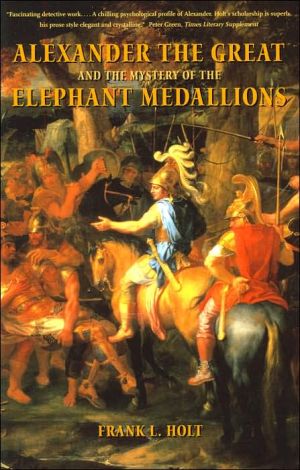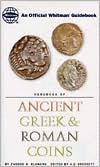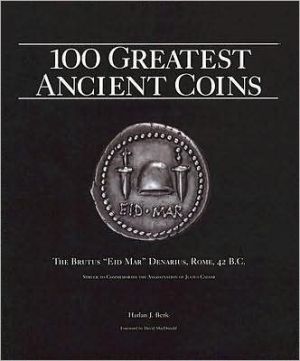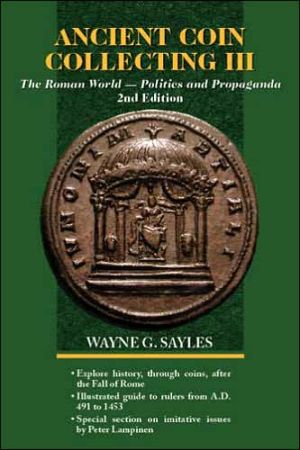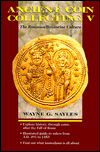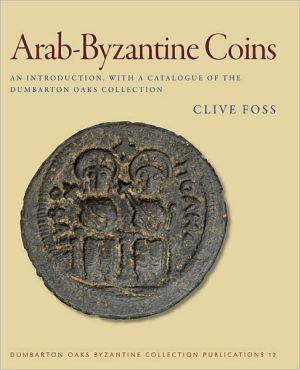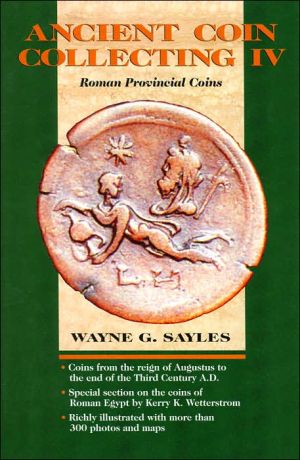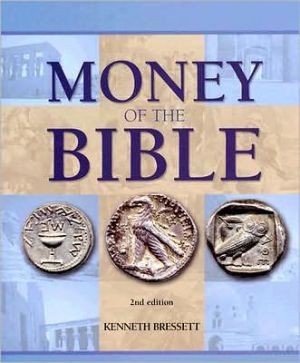Alexander the Great and the Mystery of the Elephant Medallions
To all those who witnessed his extraordinary conquests, from Albania to India, Alexander the Great appeared invincible. How Alexander himself promoted this appearance - how he abetted the belief that he enjoyed divine favor and commanded even the forces of nature against his enemies - is the subject of Frank L. Holt's book.\ Solid evidence for the "supernaturalized" Alexander lies in a rare series of medallions that depict the triumphant young king at war against the elephants, archers, and...
Search in google:
"Frank Holt probably knows more than anyone alive about the mysterious Greek kingdoms in Bactria and on the frontiers of India that were one of the odder legacies of Alexander's Eastern conquests. The literary evidence is sparse, the coins remain ambiguous, the topography defeats all but the toughest. Holt's forays into this world are those of a clever and persistent detective: he loves cracking problems, and the tougher they are, the better. This time—very properly beginning by invoking the name of Sherlock Holmes—he has given us what Conan Doyle would probably have called 'The Adventure of the Elephant Medallions.' Debate has raged over the scene these portray ever since the first was discovered. A cavalryman with a lance confronts an opponent on an elephant. Who are they? What is the occasion? Guesses have ranged from Alexander to the Greco-Bactrian monarch Eucratides, from Porus at the Jhelum to Darius at Gaugamela. Using his numismatic and historical skills like a Holmesian magnifying-glass, Holt takes us through the theories, deftly explodes the fallacies, and comes up with a (for me) entirely cogent and satisfying solution. He has also, somewhere along the way, acquired a really marvelous prose style. Not only is the problem in itself a page-turner; Holt also throws in, by way of introduction, the best short impressionistic account of Alexander's career I have ever read. This is high scholarship at its most exciting."—Peter Green, author of Alexander of Macedon, 356-323 B. C.: A Historical Biography"[This book] brings to a wider audience one of the few contemporary pieces of evidence for the image and ideology of Alexander the Great. While relatively well known to experts in the field, the 'elephant medallions' of the title are far less well understood, and have thus played a smaller part, in popular accounts of Alexander than they probably should. Holt's book offers a well thought out introduction first to Alexander and the Alexander story, second to the entrance of the 'medallions' into modern scholarship, and third to the medallions themselves."—Andrew Meadows, Curator of Greek Coins, British MuseumLibrary JournalTo justify this intriguing work, Holt (history, Univ. of Houston; Thundering Zeus) quotes Harvard classics professor Ernst Badian: "Coins will one day be the most important source [for Alexander studies], since independent of literary conventions and prejudices." While Holt traces the historical background of the famous Elephant Medallions (bearing the warrior likeness of Alexander) since their discovery in 1880, the book's value lies also in its review of Alexander studies. Holt looks at the changes that have taken place in the field since these artifacts first appeared in Afghanistan and Iraq and ably illustrates the last 150 years of scholarship. Whether one is truly interested or not in the numismatics of the period, this work will fascinate. For students who may worry that little work remains for historians, this book is certainly encouraging. Holt's efforts toward creating a mystery of sorts is a tad tired, but the history of the Medallions is literally the stuff of Kipling-and it's historiography at its best. Recommended for academic collections.-Clay Williams, Hunter Coll., New York Copyright 2003 Reed Business Information.
Alexander the Great and the Mystery of the Elephant Medallions\ Hellenistic Culture and Society, XLIV \ \ By Frank L. Holt \ University of California\ Copyright © 2003 Regents of the University of California\ All right reserved.\ ISBN: 0-520-23881-8 \ \ \ Chapter One\ Man of Mystery \ Few men have transcended their moment in history more than Alexander the Great of Macedonia (356-323 b.c.e.). He reigned as king from the time he was twenty, had conquered most of the world he knew to exist by the time he was thirty, came to be seen as a living god, and then died before he was thirty-three. His short life cast a shadow so long that it has eclipsed over one hundred generations of famous generals from Caesar and Charlemagne to Napoleon and Eisenhower. Admired and despised, he has always evoked strong passions. St. Augustine considered Alexander a rogue with a global appetite for plunder; Dante put him in the seventh circle of Hell in the company of tyrants, murderers, and thieves. In 1848, Jacob Abbot indicted Alexander for "the most gigantic case of murder and robbery which was ever committed by man." Yet Pope Paul III, Louis XIV of France, and Philip V of Spain all commissioned paintings of Alexander's inspirational deeds to adorn their palaces; Dryden wrote a famous poem about the king ("Alexander's Feast"), and Handel set it to music. The young Sigmund Freud idolized Alexander and lobbied his parents to name his new brother in honor of the hero. In 1810, Thomas Jefferson advised Governor John Langdon that Napoleon's mania for Alexander would most likely lead the Frenchman east in his footsteps, thus sparing America from possible invasion. Were Alexander alive today, one writer has gushed:\ His sprawling holding company, Alexander, Inc., would span a dozen advancing technologies, from supercomputers to bioengineering. Watch him take over NASA's foundering space shuttle program and send a man to Mars by 2010. See him negotiate the opening of a Joint Economic Zone in Hokkaido, where U.S. and Japanese partners would build massive electronics and manufacturing plants to export goods to the United States and the rest of the world. Alexander's philanthropic works might serve as a standard of public-spiritedness for decades, perhaps for generations.\ This unlikely creature, an entrepreneurial and managerial Macedonian philanthropist/conqueror, illustrates the lengths to which some will go to fashion Alexander into the man of their dreams. An envious Julius Caesar wept in Spain at the mere sight of Alexander's statue. Pompey the Great rummaged through the closets of conquered nations for Alexander's 260-year-old cloak, which the Roman general then wore as the costume of greatness. In his zeal to honor Alexander, Octavian (the future emperor Augustus) accidentally broke the nose off the Macedonian's mummified corpse while laying a wreath at the hero's shrine in Alexandria, Egypt. The unbalanced emperor Caligula later took the dead king's armor from that tomb and donned it for luck. The Macriani, a Roman family that rose to the imperial throne in the third century c.e., always kept images of Alexander on their persons, either stamped into their bracelets and rings or stitched into their garments. Even their dinnerware bore Alexander's face, with the story of the king's life displayed around the rims of special bowls. A century later, this obsession had spread far and wide. St. John Chrysostom, the patriarch of Constantinople, complained that many people in his day bound the coins of Alexander to their heads and feet to ward off evil. In the latter stages of imperial Roman history, Alexander's portrait could be found on coins and tokens of all kinds. Napoleon III purchased a stunning set of such artifacts found at Tarsus in the mid nineteenth century; struck in gold, each specimen bears Alexander's name and a scene from his extraordinary life. The ancient relics of the king remain important to us today as the prizes of museums and private collections around the world. Some examples underscore the intensity of this infatuation. André Malraux, when French minister of culture, reportedly tried to buy for the Louvre a silk scarf said by his medium to have belonged to Alexander the Great. In her trance, this psychic claimed to see the young warrior cough up a wad of bile and then fall dead upon the sand. The search for those physical remains and the lost sepulcher that held them has long been the Holy Grail of tomb archaeology. Robbed, as we have seen, of various items by overzealous ancient admirers, the grave keeps turning up in the unlikeliest modern places. In 1801, the British captured what they believed to be Alexander's coffin in the filthy hold of a French hospital ship, La Cause. Napoleon's men had found the sarcophagus in Alexandria, along with the famous Rosetta Stone. It was rumored that Napoleon planned to be buried in the borrowed coffin of his hero. The sarcophagus, seized by the British, now resides in the British Museum, near the Rosetta Stone, from whose text Jean-François Champollion eventually deciphered Egyptian hieroglyphics, making it possible to read the inscrutable carvings on the "Alexander Sarcophagus"-which turned out to have belonged, not to Alexander, but to Pharaoh Nectanebo II. This revelation reopened the search for the real grave of Alexander the Great.\ In 1887, another "Alexander Sarcophagus" was unearthed at Sidon (now in Lebanon) and taken to Istanbul. Although its marble sides are decorated with images of Alexander in battle, scholars later determined that it was the coffin of a contemporary Phoenician named Abdalonymos. So the quest continued. The grave remains elusive to this day, even though at least eight announcements of its discovery have been made since 1800-all of them quite false, and some utterly fantastic. Alexander's tomb has been found in Alexandria, Siwah, Central Asia, and even a secret cave in southern Illinois. From the graveyard scene in Shakespeare's Hamlet (see chapter 2 below) to Hollywood's blockbuster Cleopatra (or the more lackluster 1989 movie The Serpent of Death), Alexander's whereabouts still fascinate us. According to popular Greek legend, sailors are still confronted at times by a Nereid who asks, "Where is the great Alexander?" Only one response will satisfy the dangerous creature: "Great Alexander lives and reigns!" The king remains a potent force in modern pop culture: for a mere $10,000 a night, the weary traveler can lounge in the Alexander the Great Suite at the Trump Taj Mahal Casino Resort in Atlantic City, New Jersey, perhaps wearing an Alexander the Great World Tour 336-323 b.c. T-shirt (listing major stops in the king's campaigns), sipping an Alexander the Great cocktail, listening to Iron Maiden sing about the youth who "became a legend 'mongst mortal men," and reading about him in Anne Rice's Servant of the Bones. At this moment, several new movies and miniseries are in production to meet the public's insatiable appetite for legends of the Macedonian conqueror. While the rest of us wait impatiently for our fifteen minutes of fame, Alexander has already enjoyed his share 82 million times over.\ Everything about Alexander evoked awe among his contemporaries and still does so today. In the past forty years alone, experts have published more than 2,000 books and articles in a painstaking effort to solve the fundamental puzzles of his life. There we read that Alexander personally dreamed up the lofty ideal of world brotherhood and paved the way for universal religions of peace and love. We learn, too, that he conquered and killed with epic abandon, unable to sate his lust for innocent blood. He exhibited the noblest virtues of friendship and chivalry, and he butchered his closest companions out of raging insecurities. He was enlightened, intelligent, and temperate; he was insane and addicted to violence and alcohol. These studied portraits of Alexander as both a sensitive youth and a psychopath could not be more controversial and contradictory.\ Modern scholars did not, of course, invent this mystery. We have simply inherited the problem from many generations of writers, going all the way back to the fourth century b.c.e. Even then, Alexander emerged upon the world stage, it might have seemed, from the smoke and mirrors of a magician's trick. With all eyes fixed upon the dazzling reign of his father, King Philip II, no one expected the young Alexander to so upstage his sire. Through war and diplomacy, Philip made himself a difficult act to follow. In 359 b.c.e., Philip had taken the throne of a kingdom in disarray. Macedonia had lost nine monarchs in forty years, at least five of them to assassination, and the latest-Philip's older brother Perdiccas III-to a devastating invasion.\ Macedonia was a tough place that bred a tough population. To survive in the midst of so many enemies on the northern fringes of the Greek world, the Macedonians held fast to the heroic warrior code of Homer's Iliad and Odyssey. They seemed a time warp back to the Trojan War and the bellicose Bronze Age. In battles, brawls, and drinking bouts, the Macedonians measured a man from king to commoner by the implacable standards of Achilles and Agamemnon. Risks ran high among such aggressive egos, and no offense passed unanswered. Even kings could not afford a slip in the company of such warriors; hesitation or error meant speedy elimination. Philip thus led his troops with conspicuous bravado, enduring horrendous battle injuries to his face, arm, collarbone, and leg that left him half-blind and hobbling the rest of his life. These were the legitimizing wounds of a warrior king.\ In the eyes of many Greeks outside of Macedonia, Philip and his subjects appeared backward and barbaric-they were like the hard-riding, hard-fighting, hard-drinking cowboys of the lawless American frontier to the socialites of nineteenth-century Boston and New York. The women of Macedonia were no less hardened than their husbands. Alexander's mother Olympias (one of Philip's seven wives) savagely murdered her husband's last wife and child, and later she waged what one contemporary called "the first women's war." Macedonian royal polygamy may have been designed to ensure a wide selection of worthy heirs, but it also destabilized the family, court, and kingdom in a winner-take-all world. Yet out of this chaos, Philip II slowly created the most powerful political and military state in all of Greece-surpassing even Athens and Sparta. This alarmed some Greeks and encouraged others. The former, led by the eloquent Demosthenes, warned that Philip would enslave the whole of Greece; the latter, rallying to the rhetoric of Isocrates, had for some time been looking for a leader to unite them against a long-standing foreign enemy, the mighty Achaemenid Empire of Persia. As Philip's power grew, Isocrates called upon him to assume this enormous task. Meanwhile, as his father became the most famous man in Europe, Alexander fretfully absorbed the competitive ethos of his heroic ancestors Achilles and Hercules, studied philosophy under the tutelage of Aristotle, learned the art of war from his father, and challenged himself to change the world when (and if) his chance ever came. That dramatic moment arrived, appropriately enough, when his father strode at the height of his glory into a crowded theater. In 336 b.c.e., Philip had assembled dignitaries from all over Greece to witness the wedding of his daughter and launch the long-awaited invasion of Persia with lavish fanfare. Then, without warning, Philip fell dead before the throng-the victim of an assassin's dagger. His son Alexander, barely out of his teens, was hauled from the shadows and hailed the new king of Macedonia. It was an impressive entrance in the opening act of a show that has no equal in history. From that theater, when the dust had cleared, Alexander would guide men as much as three times his age on an epic march that made him master of an unprecedented empire stretching from Olympus to India. Every part of that story is a mystery.\ Alexander began with a lightning Balkan campaign that made believers of many who lacked confidence in the untested king. To secure his inheritance and silence his critics, Alexander led the Macedonian army against rebellious tribes as far north as the Danube River and as far west as modern Albania. He then plunged south into the heart of Greece and punished the defiant city of Thebes by pulling down most of its buildings and selling its citizens into slavery. The message was clear. Athens and other cities quickly acknowledged Alexander's right to lead the Panhellenic attack on Persia originally planned by his murdered father. With a coalition army of about 37,000 troops, Alexander launched the invasion in the early spring of 334 b.c.e. Before he was twenty-six, Alexander would defy all odds and defeat the Persians in a series of battles that rocked the cradle of civilization from Egypt to Mesopotamia.\ Exceeding everything ever expected of Philip, Alexander seemed invincible. He came ashore in Asia Minor wearing full ceremonial armor and symbolically cast a spear into the beach to claim the East by right of conquest. At the Granicus River (334), a regional Persian army reinforced with Greek mercenaries tried to stop Alexander's relatively small force. The young king, still earning his throne, was nearly killed in a brash charge into the enemy's lines. But his companions rallied to the cause, crushed the Persian cavalry, and slaughtered the mercenaries. This first victory awakened the Greek and Persian worlds to Alexander's potential for greatness; but, given the many factions that so badly wanted him to fail, every such military engagement had to be a make-or-break triumph. He could not lose and live to fight another day. He had embarked upon a career of conquest so circumscribed by foreign and domestic dangers that it demanded absolute perfection-a statesman's nightmare, a general's torment, a mortal's impossibility. Only a steely survivor of the Macedonian court, with its daily tests of nerve and talent, could stand these pressures and believe so completely in his own star.\ From the Granicus River, Alexander turned south to take the Ionian Greek coastal cities of Asia Minor. He faced strong resistance at Miletus and Halicarnassus, but Macedonian siegecraft eventually won the day. Along the march, two highly publicized incidents took place that were embellished to manifest Alexander's unique standing among men and gods. Along the beaches beneath Mt. Climax, the king and his entourage suddenly found themselves blocked by menacing waves crashing across their path. Then, just as quickly, the waters calmed and fell back, as though bowing before Alexander-an apparent sign of his divine power and protection. Later, as the army wintered inland at Gordium, Alexander allegedly solved the intractable problem of the Gordian Knot.\ \ Continues...\ \ \ \ Excerpted from Alexander the Great and the Mystery of the Elephant Medallions by Frank L. Holt Copyright © 2003 by Regents of the University of California . Excerpted by permission.\ All rights reserved. No part of this excerpt may be reproduced or reprinted without permission in writing from the publisher.\ Excerpts are provided by Dial-A-Book Inc. solely for the personal use of visitors to this web site. \ \
List of Maps and IllustrationsPreface1Man of Mystery12A Treasure233Picking a Fight474Whose Pachyderm, Whole or Halved?685Another Treasure926A Closer Look1177A Dark and Stormy Night139App. AThe Published Elephant Medallions167App. BSome Possible Forgeries of the Large Medallion171App. CThe 1973 Iraq Hoard173Select Bibliography175Index191
\ Library JournalTo justify this intriguing work, Holt (history, Univ. of Houston; Thundering Zeus) quotes Harvard classics professor Ernst Badian: "Coins will one day be the most important source [for Alexander studies], since independent of literary conventions and prejudices." While Holt traces the historical background of the famous Elephant Medallions (bearing the warrior likeness of Alexander) since their discovery in 1880, the book's value lies also in its review of Alexander studies. Holt looks at the changes that have taken place in the field since these artifacts first appeared in Afghanistan and Iraq and ably illustrates the last 150 years of scholarship. Whether one is truly interested or not in the numismatics of the period, this work will fascinate. For students who may worry that little work remains for historians, this book is certainly encouraging. Holt's efforts toward creating a mystery of sorts is a tad tired, but the history of the Medallions is literally the stuff of Kipling-and it's historiography at its best. Recommended for academic collections.-Clay Williams, Hunter Coll., New York Copyright 2003 Reed Business Information.\ \
